Self-propelled mortar installations
Patria AMV has become a popular platform that can receive, including mortar complexes. Poland ordered 690 of such machines in 2007, a significant number of them were supplied in the Rosomak configuration (in the photo the Rosomak version of the Polish Army)
While almost all armed forces widely use mortars as indirect-fire firing systems, self-propelled mortars remain a niche product. The article provides information on the main programs for self-propelled mortars, currently underway, along with the latest major purchases.
One of the reasons for the limited use of self-propelled mortars is that the mortars serviced by the calculations were carried for a long time by armored personnel carriers and simply fired through open hatches in the hull. The disadvantages of such platforms include a limited sector of fire, the vulnerability of calculation to the enemy’s fire, as well as to nuclear, biological and chemical weaponsand the lack of a fire control system.
In contrast, a specially designed self-propelled mortar is a weapon system mounted on a turntable or in a turret that can be rotated all 360 degrees and which offers excellent levels of protection for the crew and weapons and a fully integrated fire control system (LMS). Installing a mortar on an armored vehicle also allows you to increase the caliber of weapons, as a rule, to 120 mm. As a result, almost all self-propelled mortars are offered by this caliber. This makes it possible to significantly increase the firepower compared to 81-mm or 82-mm mortars, which were previously standardly used to support infantry.
China
The Chinese development of 120-mm self-propelled mortars began with the development of the PLL-05 company North Industries Corporation (NORINCO) based on the chassis of the six-wheeled BTR NORINCO WMZ551, which is a further development of the model NORINCO WZ551. PLL-05 was shown to the public in October 2009 of the year; no less than 50 of these machines delivered to the Chinese army. Another NORINCO CS / SM120 2 system, shown at the end of 2014 of the year, is based on an eight-wheeled chassis and may be identical to the Type 07PA system that was offered by Poly Technologies in 2012 and is based on the Type 07P 8X8 BTR. In 2013, Tanzania became the first overseas customer of the Type 07PA, ten cars were delivered by the 2014 year. The Chinese tracked vehicle PLZ-05A is based on the ZBD-08 BMP. The PLZ-05A is most likely intended for export, where it will compete with the Russian 2-31 mortar complex produced by Motovilikha Plants (see below).
The double-barreled mortar installation for state-owned loading AMOS 120 mm is installed on the Patria AMV chassis (Armored Maodular Vehicle - modular armored vehicle). This mortar complex provides high firepower with a relatively small chassis and a high level of deployability.
Finland
The Finnish company Patria is the leading developer of 120-mm self-propelled mortar systems for wheeled and tracked chassis, as well as for shipboard applications. The development of AMOS (Advanced Mortar System - Advanced Mortar Complex) began in 1996 year as a joint Finnish-Swedish joint venture between Patria and Hägglunds (now BAE Systems). By agreement, Hägglunds provided the turret, into which a twin 120-mm mortar from Patria was installed. Initially, the system was developed to meet the needs of both countries, but later Sweden withdrew from this program. In 2002, Patria was awarded a contract worth 5 million dollars for the development and supply of a loading system and other technologies, including a single AMOS mortar mounted on an armored personnel carrier Patria XA-203 6х6.
In 2010, Finland issued an order for 18 AMOS complexes, delivered in 2013 to the Finnish armed forces, which provided an option for several more systems. In addition to the AMV chassis, the AMOS mortar can be mounted on BAE Systems CV90 BMPs, tracked Soviet-made MT-LBs, M113 tracked BTRs and MOWAG Piranha 8X8 BTRs. Since, after all, Swedish participation in this process is present, I must say that the BAE Systems division in Sweden, Hägglunds, continues to supply the AMOS tower. According to a BAE Systems representative: “CV90 is ready to receive the AMOS tower and we are having discussions with potential customers.”
Patria developed the NNO 120-mm self-propelled mortar as a lighter and more compact alternative to AMOS. Like the AMOS mortar, this system was installed on the AMV chassis. Mortar NEMO was first shown in 2005 year, and in 2011, the National Guard of Saudi Arabia ordered 724 light armored vehicles Light Armored Vehicles (LAV) from General Dynamics (according to some data in the amount of 110 million dollars). This number includes 36 machines with the NEMO Turreted Mortar System (TMS) mortar set. Deliveries began in 2012, and the manufacturer confirmed that 34-like systems were delivered in 2015, and the last two machines will be delivered before the end of 2015. In the middle of 2012, the NEMO TMS tower was finalized, and the Kongsberg Protector Super Lite remotely controlled combat module was installed on it.
Patria’s current sales strategy for the NEMO system is to offer a mortar tower that can be installed on a customer-defined platform, including tracked and wheeled platforms. According to the representative of the company, “Patria does not have any preferences for the platform, but naturally we offer our own AMV 8x8 chassis if the customer has not previously used this machine.”
The multipurpose armored vehicle AMPV (Armored Multi-Purpose Vehicle) of BAE Systems was selected as a replacement for the American Army's M113 BTR; In this family will enter the version of the mortar. The amount of AMPV that is expected to be ordered by the US Department of Defense may cause considerable interest abroad.
France
Thales has extensive experience in the Thales division in the field of 120-mm mortars it has acquired since the acquisition of Thomson Brandt Armaments. Thomson Brandt Armaments developed the 1992-mm mortar 120R2M in 2, and the first completed prototype was shown in the 1994 year. This weapon system is offered for installation on the Piranha BTR and AIFV infantry fighting vehicles of the Turkish company FNSS; Mortar 2R2M mounted on AIFV infantry fighting vehicles was tested in Turkey. For testing as prototypes, Italy chose the 2R2M for installation on the eight-wheeled Freccia BTR and the Dardo tracked BMP of the Iveco / OTO Melara consortium.
In 2008, Oman placed an order for six 2R2M mortars to be installed on the Renault VAB 4х4 armored personnel carriers (Véhicule de l'Avant Blindé - avant-garde armored vehicle) that are already in service with this country. In the same year, under a contract worth 19 million dollars, Malaysia ordered eight ACV-S armored combat vehicles from FNSS to install 2R2M mortars on them. A separate Malaysian contract provided for the supply of 257 BTR Pars 8х8 local company DEFTECH, eight of which were installed mortar 2R2M. Deliveries were completed in 2011. In 2009-2010 years, Saudi Arabia received 25 mortars 2R2M for installation on the upgraded 113 BTR of the Saudi National Guard.
Japan
At the start of the 90, Japan developed the Komatsu Type 96 self-propelled mortar. Although, according to the SIPRI Stockholm International Peace Research Institute, it is noted that by 2014, Japanese self-defense forces were supplied with 448 mortars, but presumably only 40 Type 96 systems entered service as self-propelled rifles, the remaining mortars are operated as towed. The Type 96 unit is armed with a 120-mm TDA mortar manufactured under license in Japan. Further development of the TDA 120-mm mortar was implemented in a smooth-bore RS2M version and a remote-controlled version of Dragon Fire for the US Marine Corps. Under the EFSS (Expeditionary Fire Support System) Expeditionary Fire Support Program, the Marine Corps received from the TDA 66 company mortars of 120 mm caliber in 2008-2013 for installation on the M327 towed mortar system, and in addition, the armament was modified for installation on the chassis Light Armored Vehicle (LAV-EFSS) from General Dynamics.
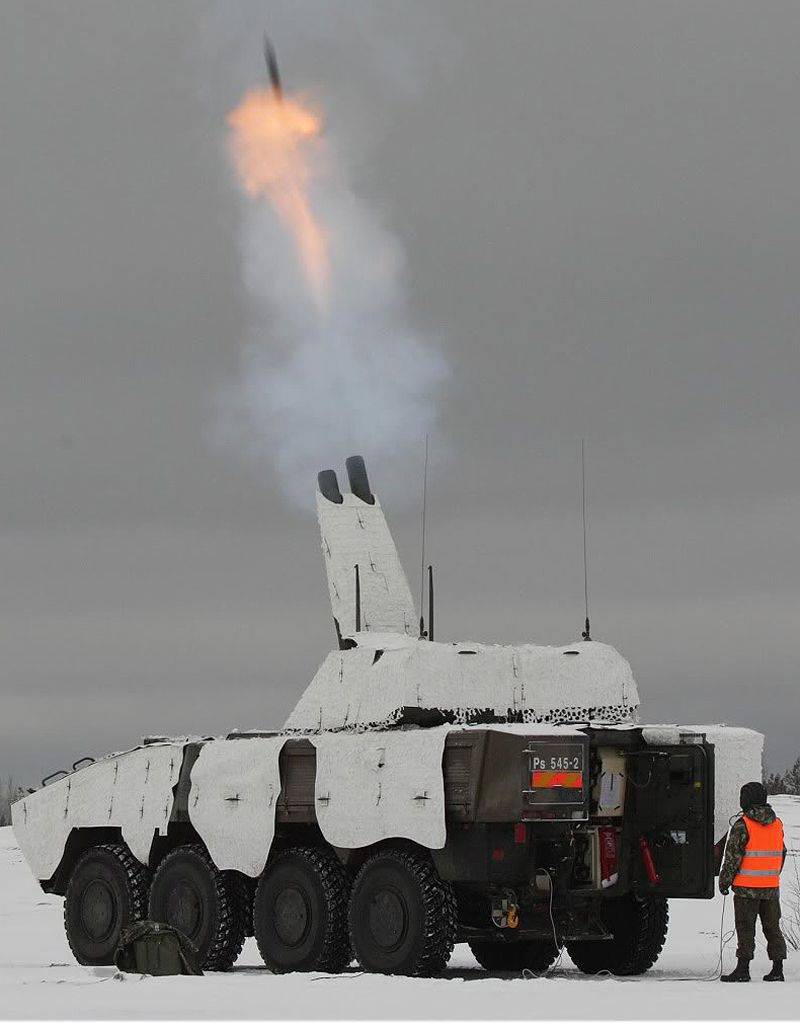
Self-propelled mortar Patria AMOS (Advanced Mortar System); On photo winter shooting tests in Finland. In total, the Finnish Armed Forces18 of such systems were supplied
Germany
The current 120-mm self-propelled mortar of the German army was originally developed by MaK System GmbH (now Rheinmetall). The Wiesel-2 tracked vehicle was selected as the chassis, and the mortar itself was installed by Rheinmetall. The first experimental model was manufactured in the 1992 year, after which the German armed forces ordered two systems delivered for testing in the 2004 year. In 2009, a contract was issued for the production of eight machines worth 60 million dollars.
Israel
In Israel, 120-mm mortars are in the “zone of responsibility” of Elbit Systems after it acquired Soltam in 2010. The self-propelled unit includes a modern, deployable, autonomous mortar complex ADAMS (Advanced Deployable Autonomous Mortar System). In 2005, as an initiative, an 120-mm Soltam mortar was installed on the chassis of an Humvee armored car (or High Mobility Multi-Purpose Wheeled Vehicle) manufactured by AM General. Mounted on the Humvee, it received the designation CARDOM (Computerized Autonomous Recoil Rapid Deployed Outrange Mortar - computerized, autonomous, retractable long-range mortar of rapid deployment). CARDOM was developed for the Israeli armed forces for installation on the M113, in addition, it was also installed on General Dynamics Stryker 8х8 US armored personnel carriers, designated M1129. In total, 2002 through 2010 was the year for the US Army Stryker combat brigades, 453 of the CARDOM system was supplied. In the Israeli army, an 120-mm mortar based on the M113 BTR is known under the designation Keshet (rainbow). The previous version of the Soltam 120-mm mortar was mounted on the US Army's M1064A3 BTR (see below).
The last foreign buyer of the mortar complex CARDOM was Cameroon, which bought eight systems installed on the chassis of an off-road Mercedes-Benz truck. Also, CARDOM was installed on a Soviet-made tracked BMP-1 for an unnamed customer and according to messages, deliveries for it have already begun. It is possible that we are talking about Azerbaijan, which bought ten CARDOM systems in 2008 for installation on a self-propelled chassis. In 2007, Kazakhstan signed a contract worth 120 million dollars, according to which 28 previously supplied 2B11 mortars were converted to CARDOM standard to be installed on MT-LB tracked chassis. These systems under the local designation Aibat were supplied in 2008-2009 years. Portugal is armed with 33 120-mm mortar CARDOM, delivered in 2008-2011 years. Finally, Uganda bought 18 CARDOM systems for installation on self-propelled chassis, delivered in 2009 year.
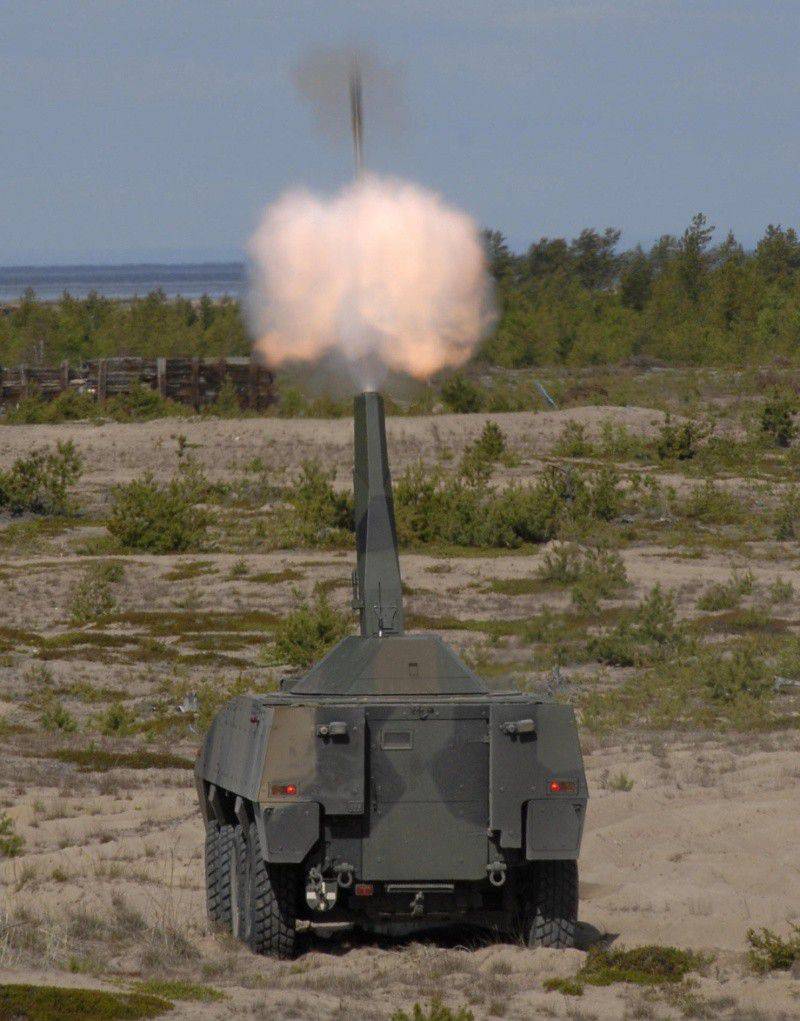
A mortar mine is fired from a Patria NEMO 120-mm mortar. This system is installed on the AMV chassis of the same company. The AMV chassis can accept either the NEMO 120 mm tower or the AMOS 120 mm tower.
Poland
In Poland, Huta Stalowa Wola developed a family of wheeled and tracked 120-mm self-propelled mortars Rak to meet the needs of the Polish army. The development contract was issued in 2007; then two towers were manufactured, one for tracked vehicles and one for wheeled vehicles. The original wheeled variant is the Patria AMV chassis. Poland ordered the 690 of these chassis, which were delivered from 2007, under the name Rosomak.
Poland has identified its initial needs in quantities from 12 to 16 systems; ultimately, it can purchase 64 systems on the Rosomak chassis and 32 tracked vehicles, naturally with funding. Today, the 120-mm self-propelled system of the company Huta Stalowa Wola is still funded by the Polish Ministry of Defense. A company spokesman said that "there is more than significant export interest," but he acknowledges that the company "must first pay attention to the local market."
Russia
For several decades Russia has been a “lawyer” of self-propelled mortars, having begun their development in the Soviet era. As for the 120-mm armament, the mortar of the cold war era 2C9 Nona-S on the tracked BTR-D chassis was first introduced in the distant 1985 year. Although this system was not offered to foreign markets, its delivery to China by Ukraine was confirmed. It is likely that, once in China, these three systems were used for the so-called reverse engineering of local self-propelled mortars (see the section on China). The lineup of the Nona mortars was expanded in the 90s through the installation of the 2C23 Nona-SVK on the chassis of the BTR-80 armored personnel carrier. In Russia, the Nona-SVK is operated in limited quantities, approximately 50 copies are in service with the Russian army and marines. The only confirmed foreign buyer was Venezuela, which received 13 Nona-SVK systems in 2011 year.
The next version of Nona was the 2C31 Vienna system, which was shown on the upgraded BMP-3 chassis. The chassis is manufactured by Kurganmashzavod, and the mortar is manufactured by PJSC Motovilikha Plants. Azerbaijan was the first foreign buyer to purchase 18 systems with deliveries in 2012-2014 years. It is expected that Vienna's 2C31 will be installed on the crawler-mounted BMP Kurganets-25 made by Kurganmashzavod, which will start mass production in the year 2017.
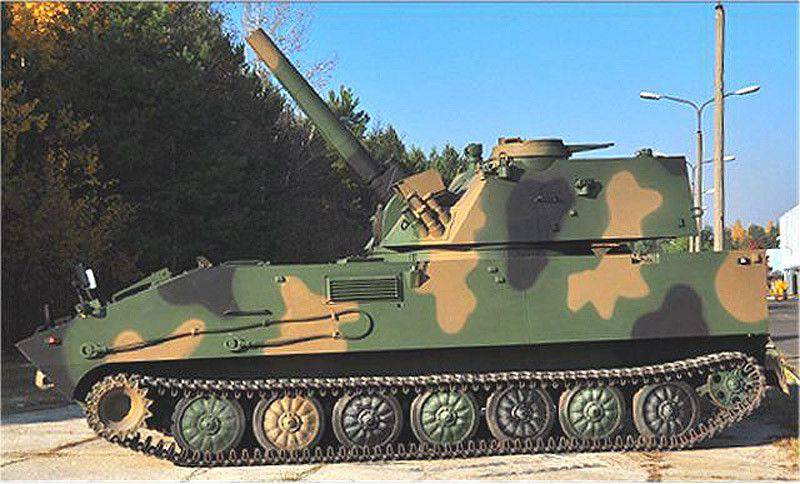
As a supplement to the 120-mm Rak mortar on a wheeled chassis, the Polish company Huta Stalowa Wola developed a variant on the 2-XNNXX tracked chassis still of Soviet design. The contract for the development of the Polish Ministry of Defense tracked version of the 1-mm mortar Rak was issued in 120 year
Singapore
Singapore's ST Kinetics (STK) has developed, as an initiative, a modern rapid-fire Mortar System SRAMS (Super Rapid Advanced Mortar System). SRAMS was first shown in 2001, and its development was completed in 2006. Compared to other 120-mm self-propelled systems, SRAMS is optimized for installation on lighter platforms, such as HMMWV armored vehicles and ATK (All Terrain Tracked Carrier) ATTC (All Terrain Tracked Carrier) articulated armored personnel carrier. For the Singaporean army, the SRAMS mortar complex was installed on the ATTC chassis.
Meanwhile, in 2006, the International Golden Group (IGG) from the United Arab Emirates began the development of the Agrab self-propelled complex, based on the SRAMS mortar. After testing Agrab Mk.1 in 2011, IGG was awarded a contract worth 320 million dollars for the Agrab Mk.72 2 complex for the supply of the UAE army. While the Agrab Mk.1 mortar complex is installed on the BAE Systems RG31 Mk.5 four-wheel chassis, the Agrab Mk.2 mortar is installed on the upgraded RG31 Mk.6E chassis and includes a Thales fire control system. According to SIPRI, another unnamed customer bought 25 complexes SRAMS for the sum of 46 million dollars with deliveries planned for 2013-2014 years.
Switzerland
The Swiss company RUAG is currently offering its 120-mm Cobra mortar, which would be presented for the first time at IDEX in February 2015. The Cobra modular system is designed for installation on various platforms and the company hopes that it will be chosen to meet the needs of the Swiss army in a self-propelled 120-mm mortar. After the initial installation on the Piranha II armored vehicle, RUAG is working on installing its new system on Piranha III and M113 vehicles.
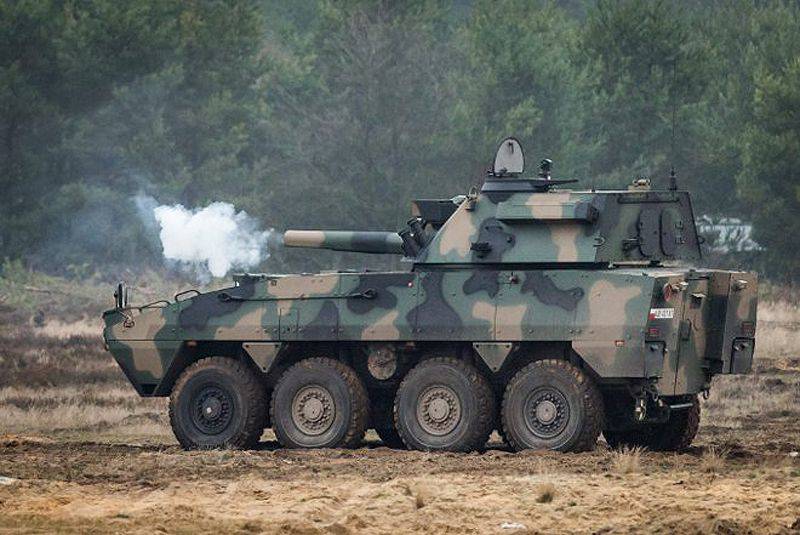
The 120-mm mortar mortar mounted on the Rosomak 8x8 BTR chassis is compatible with other types of 120-mm smooth-bore ammunition. Ultimately, Poland intends to purchase up to 64 such platforms.
U.S.
The company BAE Systems is a leader in the integration of self-propelled mortars of a new generation for the American army. In December 2014, the army issued a contract to BAE Systems for an EMD (development and pre-production) contract for the Armored Multi-Purpose Vehicle (AMPV) multi-purpose armored vehicle with an option for initial production. The total cost of the contract was 1,2 billion dollars. AMPV is intended to replace the M113 family of machines, and one of the AMPV variants will be equipped with an 120-mm mortar, which thus replaces the self-propelled M1064 mortar. BAE Systems is responsible for the machines that will accept mortar systems. Immediately after selecting the mortar complex, it integrates the 120-mm mortar and fire control system.
The latest modification of the mortar complex of the previous generation M1064 of the American Army is the M1064A3 version, which is based on the M113A3 chassis. The Soltam 120-mm mortar is installed on this machine. M1064 mortar systems were delivered to Israel in three batches, in 2007, 2008 and 2009. At least 120 machines were delivered and, most likely, they were delivered without mortars, since Soltam complexes were already installed in Israel. The new systems were also ordered by Thailand in the 2005 year, which ordered M82 113 machines, including the 12 mortar complexes M1064A3.
As seen in the CARDOM and SRAMS examples, advanced wheel chocks now allow 120-mm systems to be installed on significantly lighter chassis than before. Therefore, they are offered for installation on truck chassis or even Humvee type armored vehicles. They, as well as the self-propelled mortars themselves, can meet the needs of modern rapid reaction forces, since they use lighter and more transportable vehicles and weapon platforms. As long as the military will adhere to these concepts, the interest in 120-mm self-propelled systems will be shown for the same length of time as a means of providing highly mobile indirect fire. Another notable trend that has emerged in recent times is the alteration of obsolete machines, such as M113, 2C1 and MT-LB, for the installation of mortars. In addition, with the current fashion for mortars installed in the towers, there is a great potential that the existing combat vehicles are “quickly” converted into artillery installations. Finally, the US Army is starting a gigantic job of replacing its M113 machines, and it is likely that the AMPV project will receive significant orders from the Pentagon, which is likely to lead to a significant increase in export sales.
Materials used:
www.hsw.pl
www.baesystems.com
www.elbitsystems.com
www.norinco.com
www.armada.ch
www.stengg.com
www.ruag.com
www.patria.fi
www.wikipedia.org
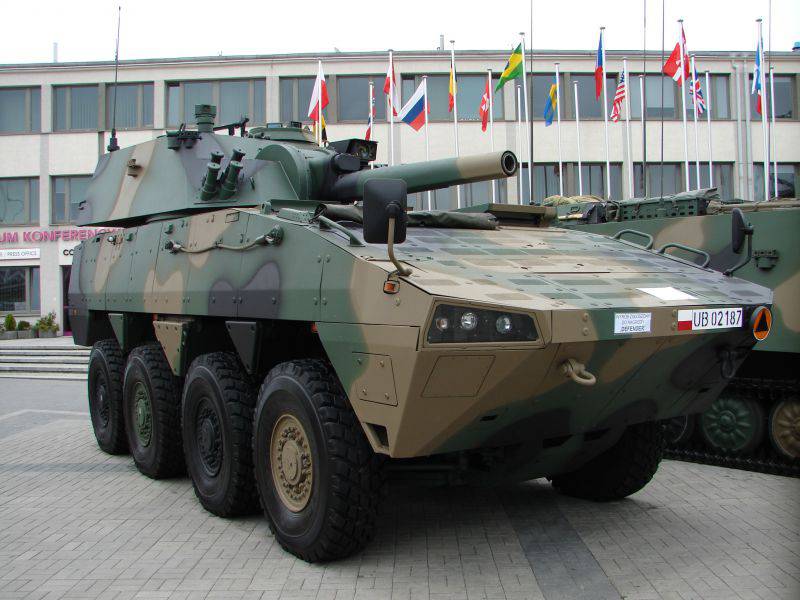
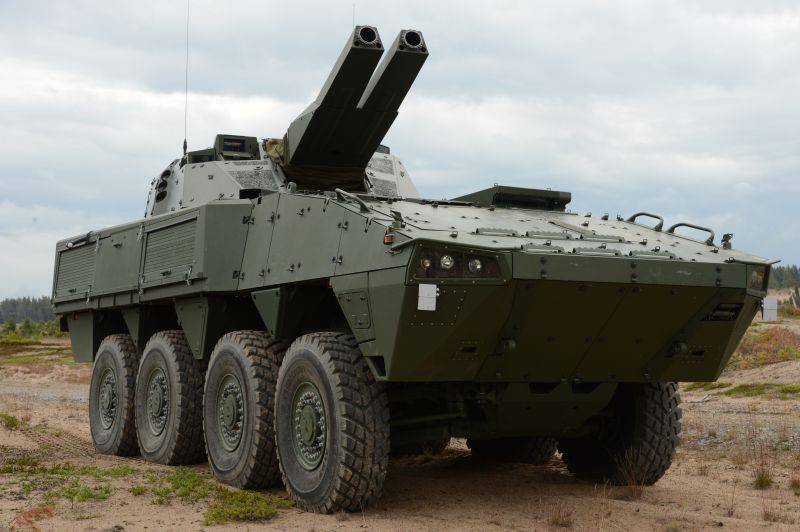
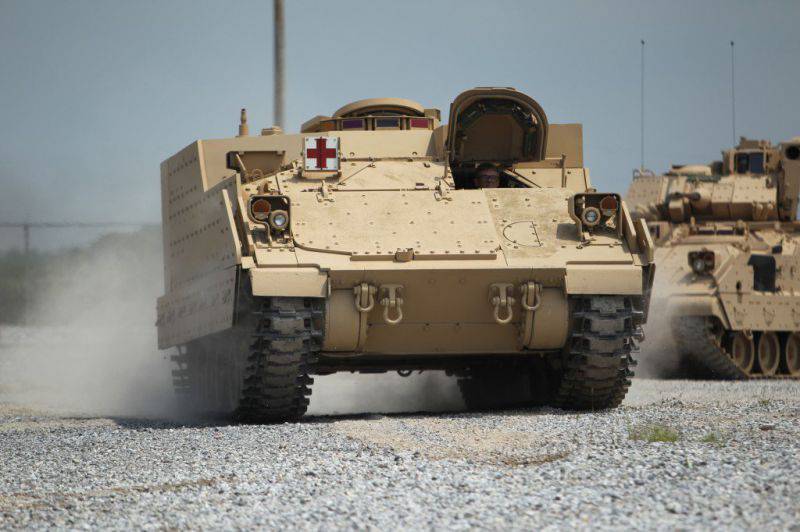
Information